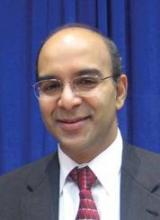SAN ANTONIO – Some breast cancers categorized as HER2 negative by conventional testing harbor mutations that may still render them amenable to therapy targeting this receptor, researchers reported at the San Antonio Breast Cancer Symposium.
A team led by Dr. Ron Bose, of Washington University and the Siteman Cancer Center, St. Louis, compiled data from eight studies in which tissue from 1,499 breast cancers was sequenced.
Results showed that 25 cancers, or about 1.7%, had activating HER2 mutations. Most of these cancers did not have amplification of the HER2 gene and thus would be categorized as HER2 negative by conventional testing.
"We argue that mutation is an alternate mechanism to activate HER2 in breast cancer," he commented. "Patients with these mutations will be missed by current HER2 testing. Gene sequencing is required to identify these mutations."
The investigational tyrosine kinase inhibitor neratinib readily outperformed lapatinib (Tykerb) at inhibiting the growth of cells bearing the HER2 mutations, according to data presented at the meeting and recently published (Cancer Discov. 2012;3:1-14). The investigators are therefore planning a phase II trial of neratinib for metastatic HER2 gene amplification–negative, HER2 mutation–positive breast cancer.
"These results show how cancer genome sequencing can be directly applied to guide individual patient treatment. HER2 mutations are a target for breast cancer treatment," Dr. Bose maintained in a related press briefing. "If this trial is successful, we estimate that 4,000 women per year in the U.S. could benefit. Worldwide, that number could be five times as large."
He anticipates that the technological feasibility and cost of HER2 sequencing in clinical practice would be similar to those of sequencing for epidermal growth factor receptor (EGFR) mutations in lung cancer.
"Within the context of the clinical trial, we are specifically screening for HER2 mutations. But in the future, outside of a clinical trial setting, probably including HER2 in a panel of genes would be most cost effective," he elaborated. "If you compare to cost of treatment, a month of treatment with many of the chemotherapy drugs or with targeted inhibitors is in the thousands of dollars. So the cost of screening [for mutations] is much lower than that."
Dr. Kent Osborne, moderator of the press briefing and director of the Dan L. Duncan Cancer Center and the Lester and Sue Smith Breast Center at Baylor College of Medicine in Houston, characterized the research as "interesting" while adding that its usefulness may be limited at present.
"But what if these mutations occur in other cancers, now that Dr. Bose has identified them?" he said. "If you are a patient with that mutation, even though it’s pretty rare, that’s important to know for you. When we get into the era of personalized medicine, where we start doing these mutational analyses, ... there are going to be mutations that perhaps are contributing to the cancer and are pretty rare in the population, but are important for that particular patient."
"Some in the audience may remember the large trial in HER2-positive patients done by the National Surgical Adjuvant Breast and Bowel Project (NSABP). A few hundred of those patients on central review did not have HER2 amplification or overexpression, yet they seemed to have the same benefits from trastuzumab as did those [with HER2]," Dr. Osborne noted. "I guess at an incidence rate of 1% to 2%, [activating mutations don’t] explain all of those by any means, but I wonder if you could get those samples from the NSABP and screen them. They could be enriched for these mutations."
"That’s an excellent possibility," Dr. Bose replied. "We have had preliminary discussions with members of the NSABP. Now that the work is published, I think those discussions will go further."
When asked why neratinib was being used in the trial instead of trastuzumab (Herceptin), Dr. Bose said that in tissue culture, the former proved much more effective at inhibiting growth of cells harboring these mutations.
On a related note, a session attendee commented, "I am modestly concerned that you don’t have trastuzumab in your trial. And the reason is that I would expect trastuzumab to down-regulate this single-copy HER2 receptor and help neratinib. So have you done combinations of both preclinically to see whether it adds or not to neratinib?"
The investigators have done such in vitro work, Dr. Bose replied. "With trastuzumab alone, we see a partial growth suppression effect when you are looking at MCF-10A cells that bear these mutations. When we tried the combination, we did not see any benefit of adding trastuzumab on top of neratinib. But I would caution that this is with MCF-10A cells, and this is in tissue culture, where there are no immune effectors. We don’t know what the situation will be in actual patients."


